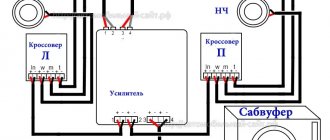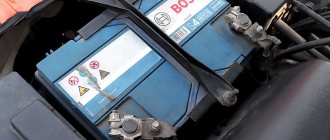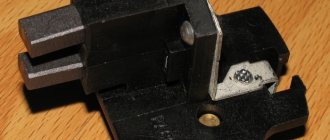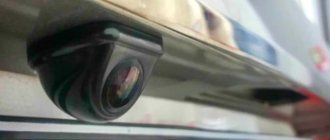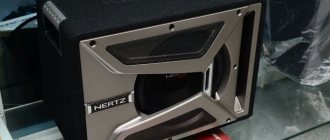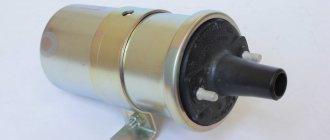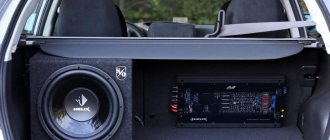The sound of a standard radio may not suit owners due to poor quality reproduction of low frequencies. It is possible to hear the bass in full only when connecting a special acoustic device - a subwoofer. The algorithm for installing an amplifier and subwoofer in a car is simple if the components are selected correctly, the correct circuit is available, and the nuances of self-installation are taken into account.
It is important to note that such work often does not require special skills, which means that any car owner can handle it, which is especially nice considering the prices for installing an audio system in specialized workshops.
Connecting a subwoofer 2 X 2
Low-frequency systems with two loudspeakers are often installed in cars. They provide great power, deep and rich bass. The connection diagram for a 2 X 2 subwoofer may differ from other options. This design can be made in the form of a closed box or work with a bass reflex. Connecting a 2 X 2 subwoofer can be done in two simple ways. This is a series or parallel connection of loudspeaker voice coils. In order to calculate the resulting resistance, a simple formula is used. The voice coil winding is a low-resistance resistor. When two 2 Ohm coils are connected in series, the total resistance is 4 Ohms, based on the formula R total = R1 + R2 or 2 Ω + 2 Ω = 4 Ω.
The connection diagram for a 2 X 2 subwoofer at 4 Ohms does not cause any difficulties, since almost all low-frequency amplifiers operate with such a load. The formula for parallel connection of resistances looks a little different. Here the resulting resistance of several resistors will be less than the smallest resistance of the parallel circuit. According to the formula Rtotal=R1*R2/R1+R2, the resistance of two 2 Ω coils connected in parallel will be equal to 1 Ω. Connecting a 2 X 2 in 1 subwoofer is associated with some difficulties, since not all models of low-frequency amplifiers can work correctly with such a load impedance. Each connection has its own specifics. If in the subwoofer connection diagram there are 2 X 2, the windings of the voice coils are connected in series, then the power will decrease by about half. Since one speaker with an impedance of 2 provides a nominal power of 500 watts, connecting a second speaker in parallel with the same impedance will reduce the system output power to 350 watts.
How to find a place for a sub
How to connect an active subwoofer
The good sound of a subwoofer also depends on the place where it is installed. To find the optimal place in the car (and there is not much of it here), you need to perform the following basic steps:
- Install the subwoofer in an open area so that every sound can be heard clearly.
- Connect the device to the car radio. After this, turn on any suitable track (preferably one that can easily hear the bass).
- It is necessary to play the melody with some excess bass to see if the system is overloaded.
- Now you should find a place in the cabin where the sound seems more muffled (for example, under the seat). It may be possible to find other places where the sound will create the highest pressure.
Note: It is advisable to choose a location that is in close proximity to other speaker systems.
You need to choose the place where the sound quality would be most suitable.
How to connect a 1 ohm subwoofer
The subwoofer connection diagram in 1 ensures maximum power from the low-frequency unit and the highest volume level. However, the quality of bass reproduction will not be the best. Low frequencies will be “smeared out”. As the load resistance of the amplifier increases, the power will decrease, but the quality of low-frequency reproduction will noticeably increase. The blurriness of the sound will disappear, and the bass will become clear and deep. You cannot connect a 1 Ω subwoofer to every amplifier model. The description of some low-frequency units specifically stipulates the minimum permissible load resistance. Loudspeakers with a 1 Ω coil are rare, so this resistance is usually obtained by connecting two 2 speakers in parallel. Connecting a 2 X 2 in 1 Ohm subwoofer can be done by using one speaker with two 2 Ω windings. They always indicate the polarity. In order for the speaker system to work correctly, you need to connect the speaker contacts correctly.
The pros and cons of the voice coils are interconnected and connected to the corresponding contacts of the low-frequency amplifier.
Connecting a subwoofer with an amplifier to the radio
How to connect a sub and amplifier to a radio depends on the design of the playback device. Most standard devices are equipped with connectors with blade contacts, which are used to connect built-in speakers. In addition, on the rear panel of the car radio there are connectors for the linear outputs of the left and right channels. They are designed for RCA or Tulip type plugs and are used to connect an external low frequency unit.
If a single-channel module is used, then to connect the subwoofer to the radio via an amplifier, you need to use an adapter. It sums the left and right channels to feed them to the input of the low-frequency block.
Connecting a subwoofer to a radio with an amplifier, in addition to switching the audio signal, involves turning on the power remotely. A separate wire is used for this. It extends from the block that is used to connect the built-in speaker systems and is labeled “Systemremotecontrol”. After turning on the car ignition and supplying power to the head unit (GU), a potential of + 12 volts is established on this wire. Low frequency units designed to work with car speaker systems have a contact that is marked in the same way. Connecting the contacts of the control unit and the amplifier ensures simultaneous power supply to both devices.
The connection diagram for a subwoofer and an amplifier in a car does not necessarily have to include automatic power supply. You can not use the remote control line, but install a regular toggle switch to turn on the power to the powerful low-frequency path manually.
How to connect a 4 ohm sub
Connecting a subwoofer at 4 is considered the most common, since most dynamic heads have such resistance, and all types of low-frequency amplifiers allow the use of such speakers as a load. You can organize a 4 ohm load using two 2 ohm speakers connected in series, when the plus of one speaker is connected to the minus of the other. The connection diagram for a subwoofer in 4 can be obtained using a two-winding speaker. Depending on their resistance, the connection configuration depends. Two coils of 8 connected in parallel will give, as a result, the required 4 Ohms. The same resistance is obtained if two voice coils with a resistance of 2 ohms are connected in series.
In the connection diagram for a subwoofer in 4, the minus of one voice coil is connected to the plus of the other winding, and the remaining free contacts are connected to the output of the low-frequency amplifier, observing polarity. Connecting two subwoofers of 4 is carried out in parallel or in series. Connecting a subwoofer 4 4 in 2 will provide increased power almost twice. The series resistance of the windings will be 8 Ω. The power will be reduced, but the bass performance will be bright and clear.
What do you need to connect?
To connect a subwoofer to an amplifier, you first need to make sure that you have everything you need. To install a subwoofer and amplifier in a car you will need:
- Set of terminals and connectors;
- Audio output converter;
- Line fuse;
- Switch for remote power supply;
- Capacitor;
- A set of wires for connecting a subwoofer and amplifier, which are selected for a specific speaker system.
To purchase the required set of wires, simply contact any store that sells sound systems for cars and tell them the model of your car and radio.
The length of the wires is determined depending on the selected connection scheme of the subwoofer to the amplifier.
Wiring
Before installing the subwoofer and amplifier, you need to decide where exactly the car amplifier will be located. You need to place the end of the power wire in the selected location and lay it under the hood of the car. To do this, you will need to measure the wire with a margin of thirty centimeters.
Some machines already have holes with rubber or plastic inserts that are designed specifically for wiring the speaker system. If holes must be drilled, extreme care must be taken to avoid damaging important components and parts. In some places, the wiring needs to be additionally protected with electrical tape.
Amplifier power
Now you need to provide power to the car amplifier. To do this, you will need to disconnect the car's power cable from the battery and connect the amplifier's power cable to it. After this, without connecting the power cable to the battery, you need to insert it into a fuse of the appropriate amperage, and only then connect it to the battery.
Grounding
The next step in installing the subwoofer and amplifier in the car is to connect the ground. To do this, you need to connect the selected wire to the amplifier and from it to a section of bare (degreased, unpainted and without signs of corrosion) metal. Before connecting the wire, it is worth sanding the selected area. Most often, you simply unscrew one of the seat bolts, attach a ground wire to it, and tighten the bolt.
Connecting the amplifier to the radio
Naturally, connecting a subwoofer through an amplifier would be pointless without a sound source, which is a car radio.
First of all, it is necessary to provide remote power. Non-original car radios usually have a blue wire that you can simply cut and connect a cable of a suitable length instead.
If you have an original radio, you need to buy a suitable switch and find a place where you will place it and perform the following steps:
- Pull the wire from the amplifier to the switch;
- Cut it in half;
- Connect the ends of the wire to two terminals;
- Pass the cut part of the wire back, leaving a margin of 30 cm.
Next, you will need to connect a capacitor, which will prevent voltage surges due to the use of the backlight in combination with powerful bass. The capacitor should be located as close as possible to the amplifier using its grounding.
In order for the capacitor to perform its function, it must be charged. To do this, you need to use a resistor with a resistance of 1 kOhm. Charging will only take a few seconds, but it's best not to touch anything with your bare hands. Checking the charge of the capacitor is carried out using a voltmeter, which should show about twelve volts.
How to connect a two-coil subwoofer
Connection diagrams for a two-coil subwoofer are limited to the following several options:
- Parallel connection
- Serial connection
- Separate connection
Most often, the resistance of the windings of low-frequency speakers is 2 or 4 ohms. With a parallel connection, the total resistance will be half the resistance of each winding. It will be 1 or 2 respectively. A series connection will give a resistance of 4 or 8 Ω. By reducing the output power, the best sound quality is achieved at low frequencies. In addition, you can connect a subwoofer with two coils without connecting them, but by using each winding for a separate channel of the low-frequency amplifier. Connecting 2 coil subwoofers must be done with strict observance of polarity. It would be undesirable for an amplifier to connect a 2 Ohm subwoofer in a bridge connection.
Each amplifier channel will operate at 1 Ω, and this is a dangerous load for some models of low-frequency equipment. The power will increase, but at the same time the current will increase and nonlinear distortion will increase. The ULF output stages will operate in a critical mode and may fail. Separate connections are allowed only if absolutely the same signal is supplied to both channels of the amplifier.
How to setup
The amplifier power can vary over a wide range. The network voltage, etc., depends on this indicator. You can configure the device through the radio. Among the features of the procedure, we note the following:
- The setup process is individual in each case. There are a large number of different subwoofers and amplifiers on sale.
- The procedure largely depends on the modification of the radio and the amplifier used.
- It is recommended to set all parameters to zero. After that, select your favorite melody and change the parameters.
Correctly setting up the music in a car with a subwoofer can be done through trial and error. When noise appears, there is a possibility that mistakes were made at the time the system was created. Most often, the problem lies in the laying of the interconnect cable near the power supply, as well as in a low-quality connection.
- How to connect a capacitor to an amplifier
- How to connect a Mystery subwoofer
- Connection diagram for radio Pioneer MVH 150UB
- How to connect a Pioneer radio
How to connect a 2 to 2 sub
The connection diagram for a 2 Ohm subwoofer is carried out according to the classical scheme, when the speaker coil is connected to a low-frequency amplifier. It is better to connect a 2 Ω subwoofer, consisting of one loudspeaker, to a separate ULF channel, since when bridged, the low resistance of the coil can damage the system. In addition to a subwoofer with one speaker, a system of two separate 2 Ohm loudspeakers or a two-winding dynamic head can be used as a ULF load. By combining the connection of the voice coils you can connect a 2 2 in 4 ohm subwoofer. To do this, they need to be connected in series. Connecting 2 x subwoofers 2 2 is carried out with a large-section multi-core acoustic cable to avoid power losses due to heating of the connections. In order to connect two 1 ohm subwoofers, the 2 ohm voice coils must be connected in parallel.
How to connect wires to an amplifier and subwoofer
To properly connect the subwoofer and amplifier, you need to select the appropriate connecting wires. Acoustic cables for connecting elements of the low-frequency complex must be multi-core, made of copper and have a cross-section corresponding to the current consumption of the amplifier. You cannot use wires from some companies that have steel or aluminum cores coated with a thin layer of copper. This is especially dangerous with high power low-frequency sound systems. To connect the subwoofer to the amplifier, ready-made sets of connecting cables are used.
This set includes wires for connecting power from the battery, wires for the speaker system, coaxial cables for supplying a signal from the radio. The kit includes a fuse, bolt-on cable lugs and fasteners. When the power of the device is low, only “+” supply voltage is supplied to it. This cable must be connected through a fuse, which is located in the engine compartment next to the battery. The minus of the block starts at the vehicle's ground. If the power of the low-frequency system exceeds 500 watts, this connection scheme cannot be used and the voltage from the battery is supplied through two wires. To reliably connect a subwoofer through an amplifier, you need to carefully tighten all threaded connections, since constant vibration when the car is moving can lead to loss of contact and failure of the sound system.
Subwoofer connection 1 1
The 1 Ohm subwoofer connection circuit is not used often, since, despite the high output power, this mode does not provide good quality reproduction of low frequencies. Some models of low-frequency car amplifiers do not allow the connection of such a small load at all. Connecting two 1 Ohm subwoofers is only allowed when the windings are connected in series. A resistance of 0.5 Ω, which is obtained with a parallel connection, can destroy the amplifier. A bridge switching circuit will reduce this value by another factor of two. When connecting a 1 Ohm subwoofer, you need to remember that as the resistance decreases, the current increases, so all connecting cables must have the appropriate cross-section. Do not use single-core wires or cables intended for electrical wiring to connect high-power speaker systems.
Connection diagram for a subwoofer in a car, 1 ohm, 1+1, 2+2, 4+4, Pioneer, Mystery, Ural, Supra
Connection diagrams for a subwoofer in 1 ohm, as well as 1+1, 2+2, 4+4 ohm
In order to successfully connect a subwoofer in your car and not burn anything, you will need everything - nothing. The subwoofer itself, one or two, is a power amplifier with sufficient power reserve, and this is at least a quarter more than the total power of both connected subwoofers. You will also need wires of sufficient quality, possibly other components of the audio system - head unit, crossovers and other devices.
But having devices alone in the household is not enough; we also need knowledge. To get them, we will look at various diagrams for connecting a subwoofer in a car; these diagrams are suitable for the most popular subwoofers of such common brands as Pioneer, Mystery, Ural, Supra and subs from other manufacturers. A subwoofer, or even two, can be connected to a power amplifier in a variety of ways, most often this is one of the connection types: serial, parallel and independent. The circuits are also divided into connections in 1 ohm, 1+1 ohm, 2+2 ohm and 4+4 ohm. Any of these methods of connecting subwoofers to an amplifier contains some nuances and rules, which we learn about from connection diagrams and a video lesson from the YouTube channel of the famous car audio store Loudsound.
Connection options: independent, serial and parallel methods, 1+1 ohm.
Connecting one subwoofer in serial and parallel way. 1+1 and 2+2 ohms. Pay attention to the impedance of different connection methods.
Also one subwoofer with two coils of two ohms - connection in series and parallel, in 4 (2+2) ohms and 1 ohm.
The same method of connecting 2 coils is a little more detailed. Serial connection 2+2 Ohm.
Connecting two fairly powerful subwoofers with two 4 Ohm coils using a 4+4 connection diagram - working in 4 Ohms. Serial connection.
Various connection schemes. Serial and parallel connection. Works in 1 Ohm, 2 Ohm, 4 Ohm, 8 Ohm.
The same diagram as presented above, in this form you may come across in various instructions, textbooks and other technical literature. We present it to you so that you can read any diagrams. Works also in 1 Ohm, 2 Ohm, 4 Ohm, 8 Ohm.
Video training for connecting a subwoofer in a car
An excellent addition to the diagrams, or even the diagrams are an addition to it. Video lesson from Loudsound in which they talk in great detail, clearly and clearly about the correct connection of subwoofers in a serial and parallel way. From the video you will learn how to select an amplifier, navigate the power of subwoofers, how not to make mistakes, and not to plant or burn anything. The knowledge presented in the video will save you from many mistakes, help save you time and money, and protect your equipment. We strongly recommend viewing!
Stereo (2-channel) and bridged connection
Stereo is a standard two-channel connection used for high-quality sound reproduction.
We need a bridge connection to increase the power delivered by the sound amplifier by reducing the resistance. Its essence is approximately the same as that of parallel connection of subwoofers.
Options for a two-channel stereo connection to an audio amplifier, as well as a bridge connection “bridge mode” (single-channel connection) of a subwoofer, and connecting a radio to an amplifier + connecting the amplifier to a battery.
Detailed wiring diagram for the subwoofer and other audio system components, view from the amplifier. Here we see the connection of a subwoofer via a bridge connection. As well as a possible option for setting up an audio amplifier.
With a bridge connection we can connect not only a subwoofer, but also connect two power amplifiers. The meaning of this action is the same - an increase in the power output from the amplifiers. You can see how to do this from a video about a bridge connection of two amplifiers from the Loudsaind YouTube channel.
More about connecting a subwoofer to an amplifier and radio in a car
We looked at possible schemes for connecting subwoofers to a power amplifier. In addition, in the presented video, we were told in sufficient detail how to do this carefully and without harm to the equipment. And yet, in order to assimilate all this information, you will need elementary, so to speak, school knowledge of physics about the nature of electricity, the flow of currents, voltage and current strength, how they are measured (power - in Watts, voltage in Volts, current strength - in Amperes, resistance - in Ohms). Without this primitive knowledge, you will do everything “at random”, risking not only the equipment, but also your own health, which, you see, is the most important. When working with currents, including the power supply system in a car, you must follow safety precautions. The wiring should be well insulated, there should be no rings, bracelets or other metal jewelry on the hands, so as not to short-circuit the contacts with them... However, this is all a separate, extensive topic, or rather even a cycle of topics. We mentioned this only to once again remind you of the need to follow safety precautions. We will be very glad and grateful to you if you listen and don’t forget about it! Thank you also for reading our article, we wish you good luck in connecting subwoofers in your car! See you on the article pages of our website!
How to connect two subwoofers to one monoblock
An acoustic low-frequency system can consist of one or two speakers. Columns in which a larger number of loudspeakers are installed are used extremely rarely due to their large dimensions. The following amplification systems can be used to organize a low-frequency channel:
- Monoblock
- Two channel amplifier
- Four-channel ULF
A monoblock is a separate amplifier that works only on the low-frequency channel. The connection diagram for two subwoofers to a monoblock depends on the resistance of the voice coil winding. If it is equal to 4 Ohms, then both parallel and series connections of windings are allowed. As a result, the total resistance of the speaker system can be 2 Ohms or 8 Ohms. Connecting an 8 Ohm subwoofer provides the highest quality bass reproduction with a minimum of nonlinear distortion. This configuration is the safest for a low-frequency unit, since the currents in the amplifier circuits will be small and the elements of the output stages will not overheat. You can connect 2 subwoofers with speakers of 2 Ohms each to the monoblock. In this option, only a serial connection is allowed if the car uses an AB class amplifier. If the basis of the low-frequency system is ULF class D, then parallel connection of loudspeakers with a total resistance of 1 ohm is allowed.
In addition to speaker systems with two speakers, speakers with two windings are often used in low-frequency channels. Typically, such heads have a winding resistance of 2, 4 or 8 ohms. You can connect a two-coil subwoofer to a monoblock, as well as separate speakers, in several ways. Since there are two coils, their separate connection to the monoblock is impossible. To do this, you need to use a two-channel or four-channel amplifier. The connection diagram for a 2 X 2 Omak monoblock subwoofer allows parallel connection of windings for ULF class D and only serial connection for other classes of amplifier equipment. The most common mistake when connecting a 2 X 2 sub is using only one winding. Some people believe that there is only one channel in a monoblock and it is enough to connect only one winding. Testing of speakers with two coils and different connection schemes showed that when only one coil is connected to the output of a low-frequency amplifier, the sensitivity of the speaker system decreases by approximately 3 dB. Therefore, you can connect a subwoofer to a monoblock only by connecting both windings.
Connection diagram to a free channel on the radio
Not always all 4 speakers are installed or connected in the car. In this case, you can connect a passive subwoofer to a free channel on the radio. The positive output is connected to a similar input on the speaker, and the negative output is connected to the negative one.
Connecting a passive subwoofer to the radio
If you install a speaker in a homemade housing, then in this case it is better to place a low-pass filter in front of the subwoofer to separate the reproduced frequencies. It can be LC, RC or RLC.
Low Pass Filter
When connected to an amplifier, no additional filters are needed. The amplifier itself separates the frequencies. So you only need to connect the sub to the low-frequency outputs.
The factory sub already has a pre-installed filter. In self-made, you need to make it yourself. There are formulas for calculating the filter, they are quite complex. For an LC filter, the inductance is L = R / (2π × Fc), where Fc is the cutoff frequency and capacitance C = 1 / ((2π × Fc)2 L).
There are several ready-made solutions. For a 4 ohm speaker and a cutoff frequency of 220 Hz, the capacitance of the capacitor will be 255 µF and the inductance 4 mH. For an 8 Ohm speaker with a cutoff of 250 Hz, C = 112 µF and 7.2 mH.
